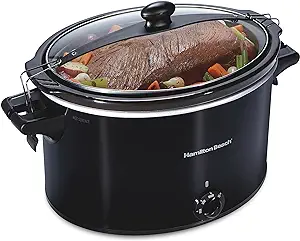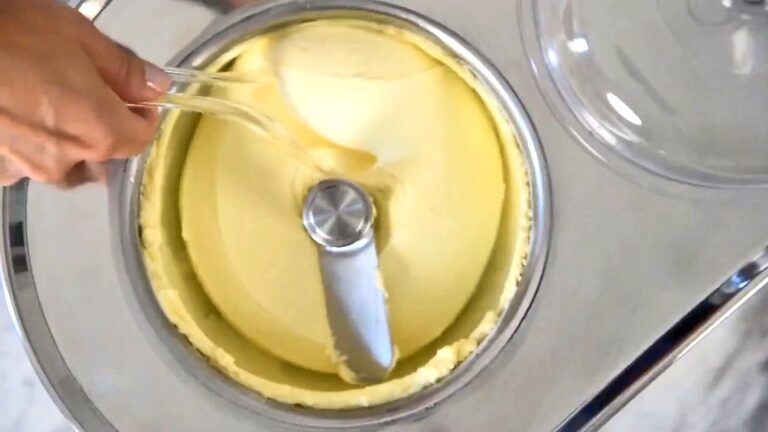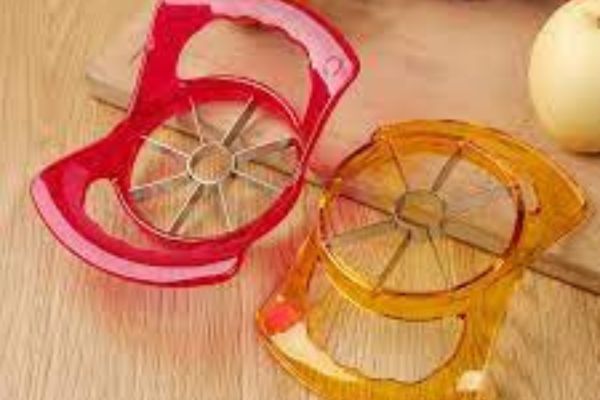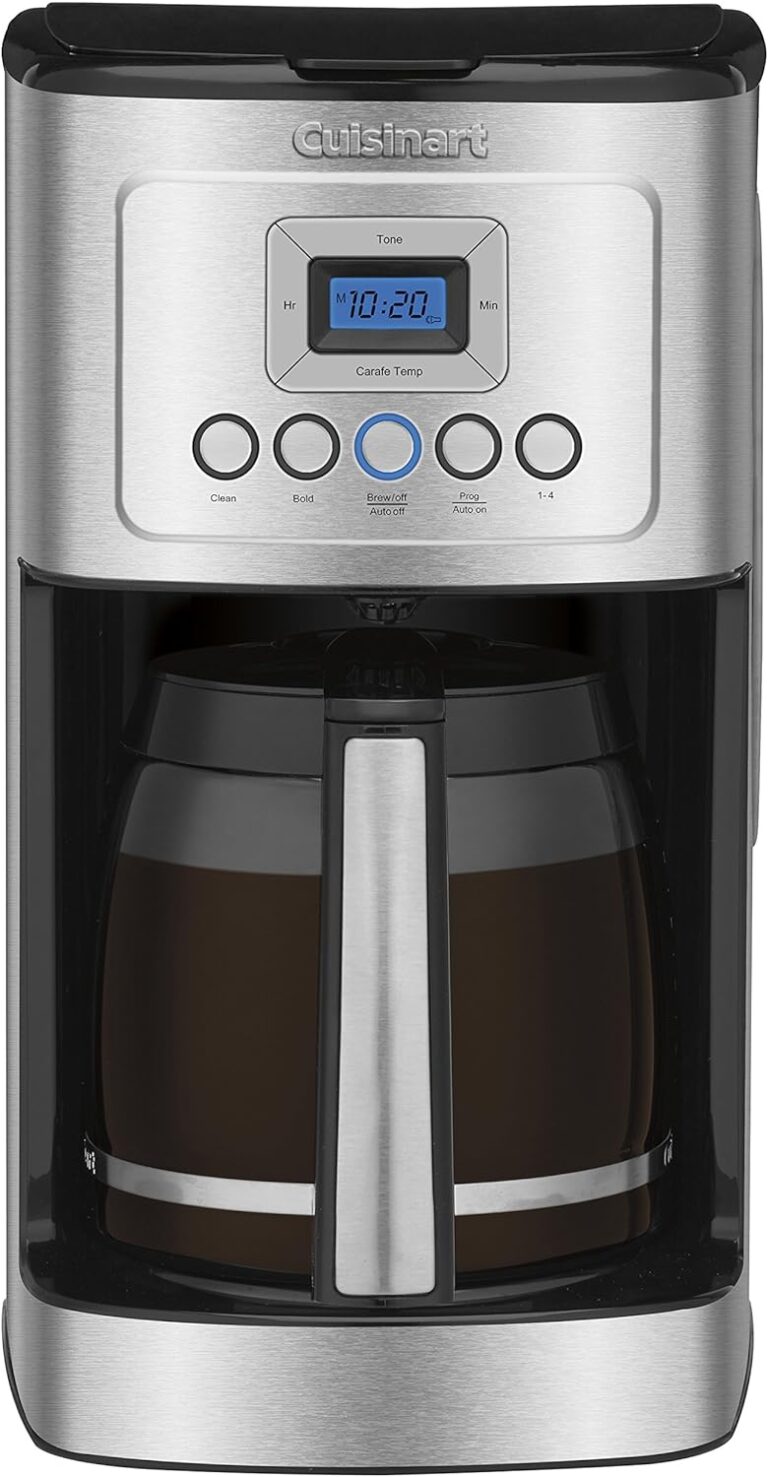How to use a pressure cooker Farberware?
Welcome to the world of efficient and convenient cooking with the Pressure Cooker Farberware! This guide will unravel the secrets to mastering this versatile kitchen appliance, ensuring every meal is a culinary triumph. From the unboxing ritual to troubleshooting tips, join us on a swift journey through the essential steps of using your Farberware Electric Pressure Cooker. Whether you’re new to cooking or have experience in the kitchen, this article guarantees to be your guide for unlocking the capabilities of this convenient, time-saving tool. Let’s dive in and elevate your cooking experience!
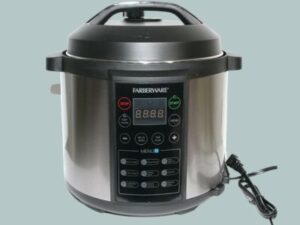
Unboxing and Initial Setup
The first encounter with your Farberware Electric Pressure Cooker sets the stage for a seamless cooking experience. Let’s break down the unboxing and initial setup process into simple steps:
Unboxing
Begin by carefully opening the packaging of your Pressure Cooker Farberware. Make sure that all the necessary parts are present and in condition. These parts typically include the unit, cooking pot, steam rack, Lid, and other accessories.
Inspection and Cleaning Pressure Cooker Farberware
Carefully check each component for any signs of damage. Clean the cooking pot, steam rack, and other accessories using soap and water. This step ensures that your first cooking venture begins with a clean slate.
Placement
Select a suitable location for your pressure cooker, considering factors like ventilation and proximity to power outlets. Place the unit on a flat and stable surface, allowing easy access to the control panel and ensuring safety during operation.
Power Connection
Connect the Pressure Cooker Farberware to a power source. Verify that the power cord is securely plugged in and that the cooker receives electricity. Confirm the power status by checking the display panel.
Initial Test Run
Before diving into recipes, perform an initial test run to familiarize yourself with the cooker’s basic functions. Add a small amount of water, seal the Lid, and set the cooker to a short cooking cycle. This step ensures the cooker functions correctly and helps you become comfortable with the control panel.
Familiarizing with Components
Take time to understand where important components like the pressure release valve, float valve, and sealing ring are located. This knowledge will be important for steps in the cooking process.
Reading the Manual
Refer to the Farberware Electric Pressure Cooker manual for specific instructions and guidelines. The manual provides valuable insights into the cooker’s features and usage, ensuring optimal performance.
Additional Accessories
Explore any additional accessories that came with your pressure cooker. Please familiarize yourself with their purposes and how to incorporate them into your cooking routine.
Register Your Product
Consider registering your Farberware Electric Pressure Cooker with the manufacturer. This step often comes with benefits such as warranty coverage and access to product updates.
Following these steps lays the foundation for a successful cooking journey with your Farberware Electric Pressure Cooker. The initial setup process ensures you are well-acquainted with the appliance’s components and functions, setting the stage for delicious and hassle-free meals.
Understanding the Control Panel Pressure Cooker Farberware
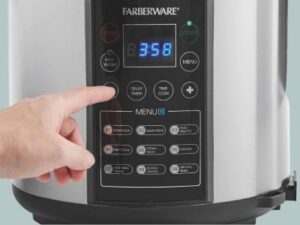
Navigating the control panel of your Farberware Electric Pressure Cooker is key to unleashing its full potential. Let’s delve into each aspect to ensure you’re in command of this powerful cooking tool:
Control Panel Overview
Get acquainted with how the control panel’s laid out. Typically, it has buttons, a digital display, and indicator lights.
Function Buttons
Discover the different function buttons available like “Pressure Cook,” “Saute,” “Steam,” and others. Each button is designed for cooking methods, giving you the flexibility to adjust the appliance according to your recipe requirements.
Time and Pressure Settings
Understand the time and pressure adjustment buttons. These controls empower you to customize cooking durations and pressure levels based on the requirements of your dishes.
Pre-Programmed Settings
Explore any pre-programmed settings available on the control panel. These settings simplify the cooking process for commonly prepared dishes, making the Pressure Cooker Farberware user-friendly, even for beginners.
Delay Start Feature
If your model includes a delay start feature, grasp its functionality. It allows you to set a delayed cooking time, perfect for planning meals or utilizing off-peak electricity hours.
Keep Warm Function
Get familiar with the functionality of the “Keep Warm” feature. This option helps maintain your dish’s temperature after cooking, guaranteeing that your meals are served at the temperature when you’re ready to enjoy them.
Pressure Release Mechanisms
Familiarize yourself with the pressure release options, such as natural release and quick release. Understanding when and how to use these ensures a safe cooking experience.
Display Panel Indicators
Interpret the indicators on the digital display. These may include pressure indicators, cooking time, and mode indicators. A clear understanding of these indicators enhances your ability to monitor the cooking process.
Safety Features
Be aware of any safety features integrated into the control panel, such as lid-lock indicators and overheat protection. These features contribute to a secure cooking environment.
Manual vs. Automatic Settings
Differentiate between manual and automatic settings. While automatic settings are convenient for specific recipes, mastering the manual settings grants you greater control over the cooking process.
By comprehending the nuances of the Pressure Cooker Farberware control panel, you empower yourself to navigate through various cooking functions effortlessly. This understanding lays the groundwork for experimenting with diverse recipes and making the most of this versatile kitchen companion.
Selecting Cooking Functions Pressure Cooker Farberware
Mastering the selection of cooking functions on your Pressure Cooker Farberware opens up a world of culinary possibilities. Let’s explore the process of choosing the right function for your recipes:
Overview of Cooking Functions
Begin by reviewing the available cooking functions on your pressure cooker. Common functions include Pressure, sauteing, Steam, and Slow cooking. Each function serves a specific purpose in the cooking process.
Pressure Cook Function
Understand the Pressure Cook function, the heart of the Pressure Cooker Farberware. This setting allows you to cook food quickly by creating a sealed, pressurized environment. Adjust the time and pressure level based on your recipe.
Saute Function
Explore the Saute function for browning or searing ingredients before pressure cooking. This versatile feature enhances the flavor profile of your dishes.
Steam Function
Utilize the Steam function for cooking vegetables, seafood, or dumplings. This setting harnesses the power of steam to cook food quickly while retaining nutrients.
Slow Cook Function
Grasp the Slow Cook function for preparing hearty stews, soups, or braised dishes. This setting allows for a longer, slower cooking process, ideal for tenderizing meats and developing rich flavors.
Keep Warm Function
Leverage the Keep Warm function to maintain the temperature of your dish after cooking. This is especially useful when your meal is ready before serving time.
Customizing Functions
Experiment with customizing functions by adjusting time and pressure settings. This flexibility ensures that your Farberware Electric Pressure Cooker adapts to the unique requirements of each recipe.
Using Pre-Programmed Settings
Take advantage of your pressure cooker’s pre-programmed settings for specific dishes. These settings simplify the cooking process, making it easy to prepare meals with minimal effort.
Combining Functions
Explore the option of combining functions for more complex recipes. For example, you can saute ingredients before pressure cooking or use steam to finish a dish.
Referencing Recipe Guidelines
When in doubt, refer to your recipe for guidance on selecting the appropriate cooking function. Recipes often provide specific instructions for the ideal setting to achieve the best results.
Adapting Cooking Functions for Recipes
Develop the skill of adapting cooking functions to suit different recipes. This versatility allows you to explore various cuisines and cooking styles confidently.
By becoming adept at selecting cooking functions, you unlock the full potential of your Farberware Electric Pressure Cooker. This knowledge empowers you to effortlessly transition between functions, ensuring that each dish is perfectly cooked. Now, let’s move forward and explore the art of adjusting cooking time and pressure levels for precise culinary outcomes.
Adjusting Cooking Time and Pressure Level Pressure Cooker Farberware
In electric pressure cooking, the ability to finely tune cooking time and pressure levels is the key to achieving culinary excellence with your Pressure Cooker Farberware. Let’s delve into the nuances of this crucial step:
Understanding Cooking Time
Recognize that cooking time plays a pivotal role in the outcome of your dish. Consult your recipe for recommended cooking times, and use this as a baseline for adjustment.
Pressure Level Considerations
Familiarize yourself with the concept of pressure levels. Higher pressure levels expedite the cooking process, making them suitable for specific recipes, while lower pressure levels are ideal for delicate dishes.
Adjusting Time for Ingredients
Take into account the type and quantity of ingredients when adjusting cooking time. Dense or more extensive ingredients may require longer cooking times, while smaller or more delicate items may need less time.
Trial and Error
Embrace a trial-and-error approach to finding the perfect balance. Experiment with different cooking times and pressure levels to achieve your specific recipes’ desired texture, flavor, and doneness.
Utilizing Pre-Programmed Settings
If your Pressure Cooker Farberware features pre-programmed settings, leverage them for added convenience. These settings are designed to adjust cooking time automatically and pressure for specific dishes.
Monitoring the Cooking Process
Stay vigilant during the cooking process. Use the digital display to track the remaining cooking time and pressure level. This ensures that you can make real-time adjustments if necessary.
Quick Release vs. Natural Release
Understand the difference between quick-release and natural-release methods for depressurizing the cooker. Quick release involves manually venting steam, while natural release dissipates pressure gradually. Choose the method that suits your recipe.
Adapting for Altitude
If you reside at a higher altitude, be aware that cooking times may need to be adjusted. Refer to altitude-specific cooking time guidelines to ensure your recipes turn out as intended.
Considering Recipe Variations
Recognize that different variations of the same recipe may require adjustments. Factors such as ingredient freshness, size, and temperature can influence the optimal cooking time and pressure level.
Recording Successful Adjustments
Keep a record of successful time and pressure adjustments for your favorite recipes. This personalized reference guide becomes a valuable tool for future cooking endeavors.
Seeking Expert Guidance
Don’t hesitate to seek guidance from pressure cooking experts or reputable cooking resources. Online forums, recipe books, and user communities can offer valuable insights into adjusting cooking time and pressure for specific dishes.
By mastering the art of adjusting cooking time and pressure levels, you gain precise control over the outcome of your dishes. This skill ensures that your Pressure Cooker Farberware becomes a reliable ally in delivering consistently delicious meals. As we proceed, we will explore the next steps in the cooking journey, including the meticulous process of adding ingredients and liquid for optimal results.
Adding Ingredients and Liquid Pressure Cooker Farberware
The success of your culinary endeavors with the Pressure Cooker Farberware hinges on carefully adding ingredients and liquid. Let’s explore the steps to ensure your recipes are infused with flavor and juiciness:
Understanding Ingredient Placement
Begin by understanding the optimal placement of ingredients in the cooking pot. Some recipes may require layering, while others benefit from a more uniform distribution.
Balancing Flavors and Textures
Consider the flavors and textures of the ingredients you’re adding. Ensure a harmonious balance, remembering that certain items may release more liquid during cooking.
Liquid Ratios
Adhere to the recommended liquid ratios provided in your recipes. Insufficient liquid can lead to undercooking, while excess liquid may dilute flavors. Strive for a balance that complements the dish.
Using Broths and Stocks
Enhance the depth of flavor by incorporating broths or stocks. These liquid bases infuse richness into soups, stews, and braised dishes, elevating the overall taste.
Avoiding Thick Sauces Initially
If your recipe includes thick sauces or creams, avoid adding them at the start. These ingredients can settle at the bottom and trigger the burn sensor. Instead, stir them in after pressure cooking.
Layering for Complex Dishes
For recipes with multiple components, consider layering ingredients. Start with items requiring longer cooking at the bottom and add quicker cooking ingredients.
Preventing Ingredients from Sticking
Add a thin layer of liquid before placing the other components to prevent ingredients from sticking to the bottom of the pot. This simple step facilitates smooth-pressure cooking.
Avoiding Overcrowding
Resist the temptation to overcrowd the cooking pot. Leave enough space for steam circulation, ensuring uniform cooking and preventing the risk of clogging the pressure release valve.
Sealing the Lid Properly
Ensure the Lid is properly sealed after adding ingredients. A secure seal is crucial for building pressure and achieving the desired cooking results.
Monitoring Liquid Levels
Keep an eye on liquid levels throughout the cooking process. Add additional liquid to prevent the cooker from reaching a low liquid level, which could trigger safety mechanisms.
Adjusting Seasonings
Adjust seasonings to taste before sealing the Lid. Once pressure cooking begins, flavors intensify, and it becomes challenging to modify the taste.
Experimenting with Flavor Enhancers
Experiment with flavor enhancers such as herbs, spices, or aromatic vegetables. These additions can transform a basic recipe into a culinary masterpiece.
By mastering the art of adding ingredients and liquid, you ensure that your Pressure Cooker Farberware becomes a vessel for infusing flavors and textures into every dish. As we progress, we’ll delve into the exciting phase of initiating the cooking process and bringing your recipes to life.
Starting the Cooking Process Pressure Cooker Farberware
With your ingredients meticulously arranged, it’s time to start cooking with your Farberware Electric Pressure Cooker. Let’s navigate through the crucial steps that mark the beginning of your culinary creation:
Checking the Lid Seal
Before starting the cooking process, ensure that the lid seal is intact and positioned correctly. A proper seal is essential for building and maintaining pressure.
Selecting the Cooking Function
Refer back to the chosen cooking function from Section 4. Use the control panel to select the appropriate function based on your recipe’s requirements, whether Pressure Cook, Saute, Steam, or another setting.
Setting Time and Pressure
Adjust the cooking time and pressure levels according to the specifics outlined in your recipe. Use the control panel to input these values, allowing your Pressure Cooker Farberware to work magic.
Securing the Lid
Ensure the Lid is securely closed and properly aligned with the cooker. The cooker will only build pressure if the Lid is sealed correctly, leading to undercooked dishes.
Monitoring the Pressure Buildup
Keep a close eye on the cooker as it builds pressure. The indicator on the control panel will signal when the desired pressure level is reached. This is the cue that the actual cooking process has begun.
Remaining Vigilant During Cooking
Once the cooking process starts, stay vigilant. Monitor the digital display for the remaining cooking time and any potential alerts or indicators requiring attention.
Avoiding Overfilling
Resist the urge to overfill the cooker. Follow recommended maximum fill levels to prevent clogging the steam release valve and ensure safe and efficient pressure cooking.
Resisting the Urge to Peek
While the cooker is pressurizing and during the cooking process, resist the temptation to open the Lid. Opening the Lid releases built-up pressure and disrupts the cooking cycle.
Utilizing Pre-Programmed Settings
If your Farberware Electric Pressure Cooker offers pre-programmed settings for specific dishes, feel free to use them. These settings streamline the cooking process, ensuring consistent results with minimal effort.
Being Mindful of Cooking Times
Be mindful of the specified cooking times in your recipe. Overcooking can lead to mushy textures, while undercooking may leave ingredients uncooked.
Taking Note of Ambient Temperature
Consider the ambient temperature in your kitchen. The cooker may take longer to reach the desired pressure in colder environments. Be patient and allow the appliance to work efficiently.
Preparing for Pressure Release
As the cooking time concludes, prepare for the pressure release stage. Follow the recommended release method based on your recipe – whether it’s a natural release or a quick release.
By adhering to these steps, you confidently initiate the cooking process, knowing that your Farberware Electric Pressure Cooker is set up for success. As we progress, we will explore the crucial steps of releasing pressure and safely opening the cooker to reveal your culinary masterpiece.
Releasing Pressure and Opening the Cooker
As your Pressure Cooker Farberware completes its culinary alchemy, the next critical steps involve safely releasing pressure and unveiling your delectable creation. Let’s navigate through these steps to ensure a smooth transition from cooking to serving:
Understanding Pressure Release Methods:
Familiarize yourself with the two primary pressure release methods – natural release and quick release. The natural release allows pressure to dissipate gradually, while quick-release involves manually venting steam for a faster depressurization.
Natural Release
If your recipe calls for a natural release, patiently wait for the pressure to drop. This method is ideal for dishes with delicate textures or prolonged cooking.
Quick Release
Carefully use the pressure release valve to release steam manually for a quick release. Exercise caution and use tools like tongs to avoid burns. Quick release is suitable for recipes where you want to halt the cooking process immediately.
Checking Pressure Indicator
Before attempting to open the cooker, check the pressure indicator. Ensure it has dropped to zero, indicating that the cooker is safe to open.
Turning the Lid
Open the cooker by turning the Lid counterclockwise. Take care to open it away from you to avoid exposure to any residual steam. The Lid should open smoothly once the pressure has been released.
Inspecting Food Texture
Once the Lid is open, inspect the texture and doneness of your dish. Be mindful of any changes that may have occurred during the cooking process.
Stirring and Adjusting Seasonings
If required, stir the cooker’s contents and adjust seasonings to taste. The flavors often intensify during pressure cooking, so this is an opportune moment to fine-tune your dish.
Using Caution with Hot Components
Exercise caution when handling hot components, including the inner cooking pot and steam rack. Use oven mitts or tongs to avoid burns.
Serving and Enjoying
With the pressure released and the cooker safely opened, it’s time to serve and savor your culinary creation. Plate your dish and relish the fruits of your Pressure Cooker Farberware prowess.
Cleaning the Pressure Release Valve
After each use, check and clean the pressure release valve. Ensures that it remains debris-free, maintaining its effectiveness in subsequent cooking sessions.
Avoiding Overcooking with Carryover Heat
Be mindful of carryover heat, which can continue cooking your dish even after the release of pressure. Factor this into your cooking time to prevent overcooking.
Storing Leftovers
If you have leftovers, store them appropriately. Use airtight containers and refrigerate or freeze as needed.
By mastering the art of pressure release and opening the cooker, you ensure that your culinary creations are delicious and safely prepared. As we proceed, we will explore the essential steps of cleaning and maintaining your Farberware Electric Pressure Cooker, ensuring its longevity and continued reliability in your kitchen.
Cleaning and Maintenance Pressure Cooker Farberware
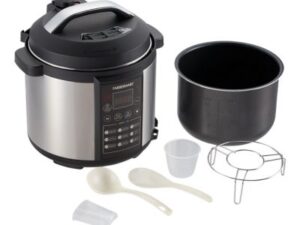
Maintaining your Pressure Cooker Farberware peak performance is essential for hygiene and longevity. Let’s delve into the comprehensive steps for cleaning and maintaining your appliance:
Cleaning the Cooking Pot and Accessories
Immediate Rinse: After each use, promptly rinse the cooking pot and accessories with warm, soapy water. This prevents food residues from hardening, making subsequent cleaning more manageable.
Hand Washing: For thorough cleaning, hand wash the cooking pot, steam rack, and any detachable components. Use a mild dish soap and a non-abrasive sponge to avoid damaging the non-stick surface.
Dishwasher Safety: Check the user manual for dishwasher compatibility. Some components may be dishwasher safe, simplifying the cleaning process. Always follow the manufacturer’s recommendations for dishwasher use.
Cleaning the Lid and Sealing Ring
Remove Sealing Ring: Take out the sealing ring from the Lid. This flexible rubber ring can trap odors, so it’s crucial to clean it thoroughly.
Hand Wash or Dishwasher: Clean the sealing ring with warm, soapy water or place it in the dishwasher if it’s safe.
Inspect the Lid Components: Check the lid components, including the float and steam release valves, for any debris. Clean these components with a small brush or sponge to ensure proper functionality.
Wiping Down the Exterior
Unplug the Cooker: Ensure the cooker is unplugged before cleaning the exterior to guarantee safety.
Damp Cloth: Wipe down the exterior with a wet cloth to remove spills or splatters. Avoid using abrasive cleaners that could damage the finish.
Cleaning the Housing and Control Panel
Dust Removal: Periodically, use a soft, dry cloth to remove dust from the housing and control panel. This helps maintain the appearance of your pressure cooker.
Avoid Liquid Exposure: Avoid allowing liquids to seep into the control panel or housing, as this can damage the electronics.
Dealing with Persistent Odors
Vinegar Soak:
- If your cooker retains odors, perform a vinegar soak.
- Mix equal water and white vinegar, soak a cloth, and wipe down the interior.
- Allow the cooker to air out before using it again.
Maintenance Tips for Longevity
Regular Inspection: Regularly inspect all components for signs of wear, tear, or damage. Replace any worn-out or damaged parts promptly.
Sealing Ring Replacement: The sealing ring may lose its elasticity over time. Consider replacing it periodically, following the manufacturer’s guidelines.
Descaling: If you live in an area with hard water, descale the cooker periodically. Use a mixture of water and white vinegar, run a cooking cycle, and then rinse thoroughly.
Proper Storage: When not in use, store your Farberware Electric Pressure Cooker with the lid upside down to allow proper ventilation and prevent odors.
By following these meticulous cleaning and maintenance steps, you ensure a hygienic cooking environment and extend the life and efficiency of your Pressure Cooker Farberware. As we conclude this guide, you’re now equipped with the knowledge to make the most of this versatile kitchen appliance. Happy cooking!
Troubleshooting Tips Pressure Cooker Farberware
Even with the best preparation, occasional hiccups may arise when using your Farberware Pressure Cooker Farberware. Let’s explore common issues and practical troubleshooting tips to keep your cooking experience smooth:
Cooker Not Turning On
Check Power Connection: Ensure the cooker is properly plugged into a functioning power outlet.
Inspect Power Cord: Examine the power cord for any damage. If damaged, replace it immediately.
Reset: If the cooker has a reset button, try resetting it.
Pressure Not Building
Seal Check: Confirm the Lid is sealed correctly. An improper seal prevents pressure buildup.
Steam Valve Inspection: Ensure the steam release valve is not clogged. Clean if necessary.
Liquid Levels: Verify that there’s enough liquid in the pot, as insufficient liquid can impede pressure buildup.
Excessive Steam Release:
Sealing Ring Check: Ensure the ring is correctly seated in the Lid. A loose ring can cause excess steam release.
Steam Release Valve: Check if the steam release valve is in the sealing position. If not, adjust it.
Burn Indicator Activated
Liquid Levels: The burn indicator may activate if there’s insufficient liquid. Add more liquid as needed.
Food Sticking: Avoid ingredients sticking to the bottom of the pot, as this can trigger the burn sensor.
Deglazing: If the burn indicator persists, deglaze the pot by adding liquid and scraping any stuck-on bits.
Lid Stuck or Difficult to Open
Pressure Release: Ensure pressure has been fully released before opening the Lid.
Align Lid Properly: Check that the Lid is aligned correctly with the cooker. Misalignment can make it challenging to open.
Inaccurate Timer or Temperature
Check Recipe Guidelines: Verify following your recipe’s recommended cooking times and temperatures.
Pressure Adjustment: If the pressure seems off, adjust the settings accordingly.
Steam Leakage
Sealing Ring Inspection: Examine the sealing ring for any damage or misalignment. Replace if necessary.
Valve Check: Ensure the steam release valve closes properly after pressure cooking.
Unusual Noises
Regular Operation: Some noise is expected during the pressure cooking process. However, inspect the cooker for loose components or foreign objects if you notice unusual or persistent sounds.
Error Codes on Display
Refer to Manual: Check the user manual for specific error code explanations and troubleshooting steps.
Contact Support: If the issue persists, contact the manufacturer’s customer support for assistance.
Uneven Cooking
Ingredient Size: Ensure that ingredients are cut to similar sizes for even cooking.
Stirring: If applicable, stir the contents during cooking to distribute heat evenly.
By keeping these troubleshooting tips in mind, you’re well-prepared to address common issues that may arise during your cooking adventures with the Pressure Cooker Farberware. Remember, a little troubleshooting can go a long way in ensuring your cooking experience remains efficient and enjoyable. Happy troubleshooting.
conclusion Pressure Cooker Farberware
In conclusion, mastering the Pressure Cooker Farberware opens up culinary possibilities. From the initial unboxing to troubleshooting tips, this comprehensive guide has provided a step-by-step roadmap to harnessing the full potential of your kitchen companion. You can create delicious meals confidently and efficiently by understanding the control panel, selecting cooking functions, adjusting time and pressure levels, and navigating the cooking process. Additionally, the insights into releasing pressure, proper cleaning and maintenance, and troubleshooting common issues ensure a seamless cooking experience. Embrace the versatility of your Pressure Cooker Farberware, experiment with diverse recipes, and elevate your culinary skills. Happy cooking!


